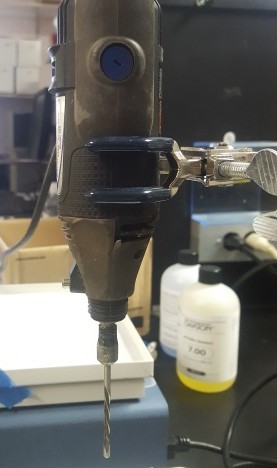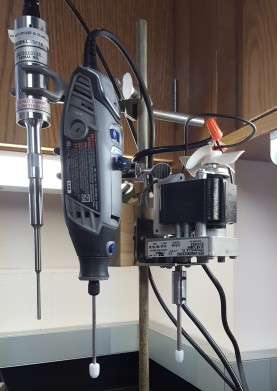 omogenizers are used in every biochem lab. They're essential for grinding
up cells and tissue samples for analysis. And as with every other kind of
lab equipment, they're overpriced.
omogenizers are used in every biochem lab. They're essential for grinding
up cells and tissue samples for analysis. And as with every other kind of
lab equipment, they're overpriced.

A Dremel 300 with a RotoZip Drywall Guidepoint spiral saw cutting bit attached
There are three main types of homogenizers: (1) Polytrons, which have concentric rotating teeth; (2) teflon pestle homogenizers and Dounce homogenizers, which smoosh the sample between a plastic or glass probe and the glass wall of a tube, and (3) sonicators, which blast the sample with high intensity sound waves. Polytron-style homogenizers are useful for very large samples (>5 grams) and for fibrous samples like muscle and cardiac tissue. Teflon homogenizers are a nightmare below ten milliliters, as are those tiny Dounce homogenizers, which often break.
Sonicators are essential in making nanoparticles and liposomes. But as my assistant discovered, when a sonicator probe contacts the air-water interface it turns your sample into a foamy mess. If your sample is smaller than about 50 microliters, a sonicator will simply spray your sample into the atmosphere, which means if it's potentially infectious you have to be loaded down with PPE as well as hearing protection. And a sonicator is likely to damage or destroy any cell nuclei. Even though you can sometimes reduce the output power of a sonicator, that means messing with resistors on the circuit board.
These days a better solution is needed. Nowadays, 20 milligrams is considered a huge sample. Until now, I've never had a good way of homogenizing them. But there's a simple solution: a variable speed Dremel with a spiral saw bit. The bits for Dremel are too short, but 1/8" drywall bits made for a RotoZip fit in a Dremel and they're the ideal size for homogenizing samples in a 1.5 ml centrifuge tube. I tested three different types.

Delrin Potter-Elvehjem style teflon-pestle homogenizers next to a sonicator probe
Drywall bits resemble ordinary drill bits. They work okay, but bits of the sample get stuck in the flutes.
Multipurpose bits have a heavily spiraled shape like a rotary spiral saw. A spiral saw is a drill bit with very sharp edges that can be dragged sideways within the drywall like a router to cut out a circular region. These bits are less likely to retain sample, but they're very sharp at the tip and they scrape up the plastic in your test tube. The tip must be ground down to prevent this.
Drywall spiral saw bits with an uncut region near the point, called guidepoint cutting bits, don't scrape the tube, and any excess sample just drips off. They're ideal for homogenizing in a 1.5-ml tube.
You can also grind down the tip of a multipurpose bit or guidepoint bit to match the shape of an 0.5-ml tube by rotating it against an abrasive. Polish the tip with Mother's Mag & Aluminum polish or equivalent to make it smooth. It's sold for aluminum but works fine on stainless steel.
Teflon homogenizeers
For gentle homogenization, such as for isolation of Golgi, a low-speed Potter-Elvehjem style homogenizer or Teflon pestle homogenizer is needed. These can be made easily by press-fitting* a Teflon or Delrin cylinder onto a piece of 1/8-inch stainless steel and then cutting it to the shape of a 2-ml plastic round-bottom centrifuge tube. A Dremel works well, but it doesn't have enough torque at low speeds and you end up homogenizing at 3000 RPM.
A Proxxon IB/E is preferred as it has much better speed stability than a Dremel. It also has more precise speed control and more torque, but its lowest speed is 5000 RPM. For a geared motor, you'd need to make a coupler to attach the pestle to the motor. An alternative is to use the standard method used by all biochemists to attach things: jam different sizes of tubing and pipet tips together.
When converting a known method to a homogenizer of a smaller diameter, the speed should be increased by the ratio of the circumferences. However, this doesn't usually make too much difference.
A sonicator or Polytron costs over $10,000. A variable-speed Proxxon IB/E or Dremel 3000 Series is 181 times cheaper and works better. And unlike a sonicator, it can also drill holes in your drywall when you're finished homogenizing.
* Press-fitting is done by drilling a hole in the larger piece that is just slightly too small for the rod to fit. Put the rod in a freezer and heat up the larger piece and squeeze the parts together. Sometimes a vise is needed. Once the temperatures equalize, the two pieces are stuck together for good. This doesn't work for all materials and it works best if the two parts are made of the same material.
dec 15 2021, 7:22 pm. updated jan 28 2022
